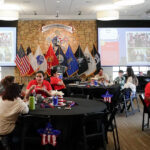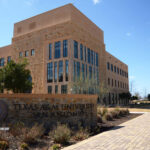Editor’s note: This viewpoint was removed from The Mesquite website under threat of censorship from the university on January 31, 2025 and updated at 7 p.m. on Feb. 10, 2025, to include additional perspective from the writer.
For me, the chance to see U.S. Supreme Court Justice Sonia Sotomayor was a once-in-a-lifetime opportunity. To have the official ticket in my hands made me think how fortunate I was to listen to another first-generation Hispanic woman like myself, and how she was able to accomplish so much and live the successful life she planned.
However, as an aspiring journalist and assistant editor of The Mesquite, I felt frustrated to know our news site would not be able to cover the event with quotes, photos and an interview with Sotomayor. Texas A&M University-San Antonio officials informed The Mesquite’s faculty advisers on Jan. 15 that Sotomayor’s representatives were prohibiting all media from reporting on her visit.
Despite being told not to, I believe sharing my experience with the A&M-San Antonio community is very important because I know that Sotomayor consistently supports free speech rights. While I respect this was a private event, I believe student media has a unique opportunity and responsibility to share with the rest of the student body what a first-generation Latina with a successful career had to say during her special appearance at our Hispanic Serving Institution.
A&M-San Antonio welcomed Sotomayor on Jan. 29 with a standing ovation, cheers and applause as she walked onto the stage of the auditorium. Watching everybody’s reactions and joy as she took her seat made me want nothing more than to have my camera ready to capture that memorable moment.
Sotomayor made a wonderful first impression as she half-jokingly explained that the reason why there was security on campus was to protect her from herself — as she likes to get close to people — and not necessarily from others wanting to cause harm.
Sotomayor was invited to be an honorary guest for the Cisneros Institute’s Distinguished Lecture Series. The event was open exclusively to faculty, staff and students who secured a ticket through a lottery system, plus other special guests.
From the moment the ticket sign-up form was open, I filled it out as soon as I could, putting a lot of thought into the questions I hoped could be asked of her. The journalist side of me was thinking about coverage opportunities but my student, Hispanic-descent side, wanted to sit down comfortably, take in and appreciate every word Sotomayor had to say for all students and anyone who has big dreams to achieve.
Lottery recipients lined up at the entrance of the auditorium and made their way through security before choosing a seat. Also in attendance were city officials such as San Antonio’s mayor, District 3 and District 4 council members, whose districts include A&M-San Antonio; Bexar County judge; and San Antonio Precinct 1 commissioner, whose precinct includes our campus. I did not expect to see so many local officials, but it made me remember the level of importance of this event and how much it meant for the City of San Antonio.
Sotomayor answered a series of questions that were submitted at the time students placed an entry for a ticket.
The questions were about Sotomayor’s journey with discrimination, stereotyping and breaking the glass ceiling as a first-generation Latina with a dream of becoming a judge. She spoke about making friends while she attended Princeton University and her struggle with assignments — translating them from Spanish to English in her head before writing them down.
While I am aware I’m not the only student for whom English is a second language, it was affirming to know that even people who have gone through a similar struggle are capable of achieving their biggest dreams with the right amount of courage and determination.
A total of eight questions were answered, each having a long and thoughtful response full of experience and wisdom from Sotomayor. Although the questions were strictly from students, I noticed that faculty and staff overshadowed students filling the seats of the auditorium. My first thought about this ratio was how it was unfair, to a certain point. This was a campus private event at a public university, so I thought students would be given priority to fill the seats. I do believe everyone deserved to attend — this opportunity is not presented on a daily basis — but since the questions she was asked came from students, the target audience for her responses would ideally be those students.
Associate Vice President for University Communications, Sarah McBride told the Mesquite that out of the 418 seats total, 300 were reserved for students.
Still, Sotomayor took her time with students who were there and showed her appreciation by interacting with them eye to eye.
Sotomayor left the stage after the second question and walked into the audience to shake hands. She also exchanged hugs and the university’s marketing team took photos of her with the students whose questions were being prompted as she poured her life experience to everyone.
She is the first speaker I have seen voluntarily leave the stage and interact with as many people as she could. For me, that spoke volumes about her character. Even for those who were seated in the higher section of the auditorium, she stood at the bottom of the stairs and joked about her ability to take those steps and greet us. That made me wish I sat a couple of rows lower.
Some of the many words of advice that were meaningful, especially to me, were to always plan everything you do but to be prepared to make changes. She suggested creating a plan by setting goals, figuring out what skills we need to achieve them, and taking it one step at a time. This way, we will eventually take enough steps to look back and see how far we have come.
With the speed my life is advancing at this stage, I want to take some time aside from my part-time job, internship, school responsibilities and social life to figure out what I want to do next in my journey. The advice she gave will not pass in vain for me.
Because the event was private, video, photography and student media were prohibited. However, A&M-San Antonio’s marketing and communications personnel were able to capture heartwarming and memorable moments that made part of the history on our campus.
I called the Supreme Court’s Public Information Office on Feb. 11 to ask them why Sotomayor’s representatives did not allow student media coverage. Their public information office said they had no comment and if the university’s final decision was based on court documentation the students should follow that.
The Mesquite was not allowed to see the final media proposal where it stated The Mesquite news coverage or an opinion piece was prohibited.
John Wickline, A&M-San Antonio’s compliance officer and public information officer, told The Mesquite that communications between A&M-San Antonio and the Supreme Court are protected as court records.
While my viewpoint is considered a violation of the terms the University agreed to with the Public Information Office of the United States Supreme Court, I am willing to take the risk. Every student has a right to a voice and a viewpoint. No public university or government official should make an agreement that prohibits students from sharing their thoughts and viewpoints about the visit of an esteemed and influential guest on our campus.
This story was updated at 2 p.m. on February 15 to clarify media restrictions, students in attendance and the protection of the Supreme Court’s records.






